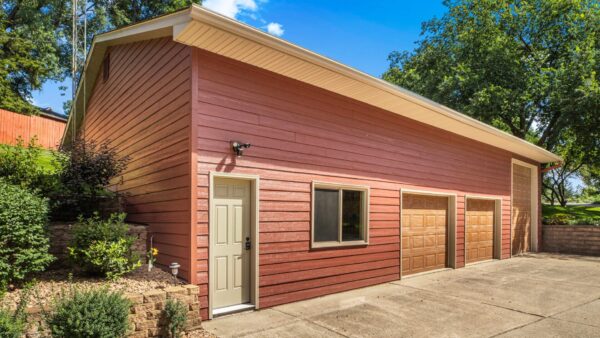Table of Contents
As winter settles over Central Minnesota, your siding quietly takes on one of its most important roles of protecting your home from wind, snow, and ice. Over time, these conditions can wear on exterior materials, leading to small gaps or weak spots that allow in cold air and moisture.
A little attention before the deep freeze can go a long way. With a few simple repairs or timely upgrades, you can keep your home warm, efficient, and protected all season long. Now, let’s look at some common signs of siding wear and what you can do to address them before the cold sets in.
Why Siding Health Matters Year-Round
Siding plays a key role in your home’s overall appearance and protection. It forms the outer layer that keeps your home comfortable and structurally sound throughout the year. When seams loosen, insulation weakens, or panels begin to crack, moisture can slip in and cause hidden damage. Regular siding care helps prevent these issues, preserving both the look and lasting performance of your home.
How Winter Weather Damages Siding in Minnesota
Central Minnesota winters put siding to the test. Cold, moisture, and wind can quietly cause damage that adds up over time.
Common winter stressors include:
- Snow piling against exterior walls or overflowing gutters that send melting water down siding, leading to stains or rot.
- Strong winds or heavy branches that scuff or loosen panels, leaving edges exposed.
- Sudden temperature drops that make older or poorly secured siding brittle and prone to cracking.
- Small gaps and fractures that allow cold air and moisture to seep in, revealing issues like swelling or peeling paint come springtime.
How to Prevent Winter Siding Damage
Many of these issues can be avoided with a little proactive attention. Before heavy snow arrives, inspect your siding for cracks, gaps, or loose panels. Look for anything that might invite moisture once freezing begins. Clean away dirt and mildew so ice and water can’t cling to the surface. Trim any branches that hang close enough to scrape against your home during a storm.
Re-seal joints and gaps around windows, doors, and corners to prevent air and water leaks. And keep your gutters clear so melting snow can flow away from your siding instead of pooling where it can cause damage. These simple habits can make a noticeable difference in how well your siding endures sub-zero stretches.
Signs It’s Time for Siding Repair or Replacement
If you notice bulging panels, peeling paint, soft spots, or areas that stay damp long after snow has melted, it may be time to call in a professional. Lutgen Companies takes a diagnostic approach, inspecting not just the visible damage but the underlying issues that cause it. From minor repairs to full replacements, our team helps homeowners choose solutions designed for long-term performance and minimal maintenance.
The Role of Insulation Behind Your Siding
The insulation behind your siding plays a crucial role in keeping your home warm and efficient during Minnesota’s coldest months. It acts as a thermal barrier, reducing heat loss and helping maintain consistent indoor temperatures. When insulation becomes damp, compressed, or damaged, it loses its effectiveness, allowing drafts and moisture to creep in.
Regularly checking for signs of deterioration such as cold spots or rising energy bills can help you catch problems early. Upgrading to modern insulated siding or adding a weather resistant barrier can also further improve comfort and energy savings year round.
Common Materials and How They Handle the Cold
Different siding materials show wear in different ways. Knowing what to look for can help you spot siding vulnerabilities.
Here are a few signs to watch for with common siding types:
- Vinyl siding: Check for cracks, chips, or panels that have loosened after freezing temperatures. Brittle vinyl can break more easily in the cold or from impact.
- Wood siding: Look for peeling paint, soft spots, or areas where boards appear swollen or warped, which are signs that moisture has been absorbed and the seal may need attention.
- Fiber cement siding: While highly durable, it still benefits from regular inspections. Watch for loose nails or caulking that needs refreshing to maintain its weather resistance.
Preparing Your Home for Next Season
A professional siding inspection goes beyond what most homeowners can spot on their own. During the visit, an expert examines every part of your home’s exterior, looking for signs of wear, damage, or moisture that may be hidden beneath the surface. They check seams, flashing, and joints to make sure everything is sealed properly and that water is being directed away from your home.
The inspector may also evaluate the condition of the underlying materials and insulation to catch early signs of rot or air leaks. After the inspection, you’ll receive clear recommendations for maintenance, repairs, or upgrades to help your siding perform its best through the seasons ahead.
Low-Maintenance Siding Solutions with Lutgen Companies
At Lutgen Companies, we’re a trusted part of the Central Minnesota community we’ve proudly served since 1983. Over the years, we’ve delivered more than 10,000 low maintenance home renovations that provide lasting comfort, beauty, and protection. Our reputation is built on honesty, craftsmanship, and a genuine commitment to helping homeowners make confident, informed decisions about their homes.
From the first consultation to the final inspection, we approach every project with care, precision, and integrity. We work with trusted brands and materials backed by strong warranties to ensure every renovation stands the test of time.
Help Your Home Withstand the Elements
Minnesota weather puts siding to the test, and keeping it in good condition is key to protecting your home year after year. At Lutgen Companies, we help homeowners spot issues early, make smart repairs, and choose durable materials that stand up to the elements.
From routine inspections to full siding replacements, our team focuses on keeping your home strong, energy efficient, and beautiful in every season. Learn more about our siding services and how we can help you prepare for the colder months ahead.




